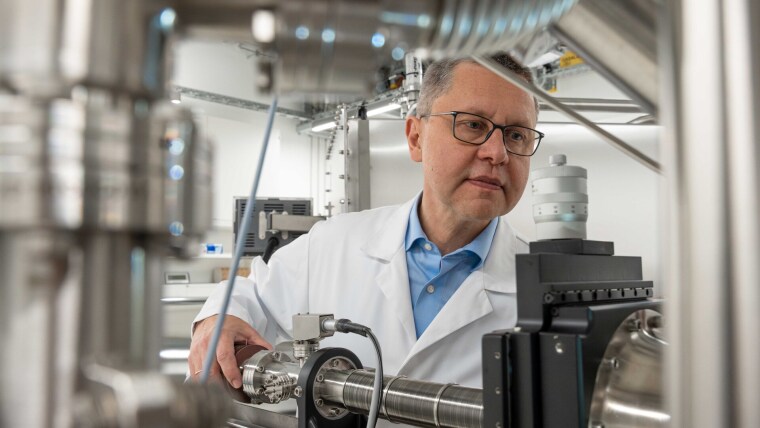
- Light
Published: | By: Sebastian Hollstein
Source article
The honored team: Prof. Dr. Andrey Turchanin (from left), Dr. Falk Eilenberger, Dr. Antony George and laboratory manager Dr. Christof Neumann.
Image: Nicole Nerger/Universität JenaTwo-dimensional materials are currently among the most promising materials of all. Thanks to their low thickness of one or a few atomic layers, which leads to a wide range of chemical and physical properties, they have enormous application potential for very different fields.
For example, they are considered a powerful alternative in the field of computer technology, where silicon components are increasingly reaching their performance limits. In recent years, Friedrich Schiller University Jena has become a centre for research into this innovative class of materials.
This is thanks to the team led by chemist Prof. Dr Andrey Turchanin. Together with his colleagues Dr Antony George, Dr Falk Eilenberger and Dr Christof Neumann, the chemist has therefore been awarded this year's Thuringian Research Prize in the category "Applied Research". The award, which was presented today (18 June) in Ilmenau, is endowed with 25,000 euros.
"We have achieved a lot in recent years and I am delighted that our work has been recognized with this award," says team leader Andrey Turchanin. "I hope that our research will attract even more attention as a result and that we can expand it into other exciting areas of application."
Customized materials
The work of the Jena team initially focused primarily on the production of 2D materials and the characterization of their functional properties in components. The researchers carried out pioneering work in the field of material production and developed a series of scalable methods for the customized synthesis of inorganic 2D materials based on chemical vapour deposition.
Extensive analyses of the synthetic materials revealed that they have excellent intrinsic properties. "If we grow the materials in this way, we can produce 2D materials for very specific applications and synthesize new materials for basic research that do not occur at all in nature," says Turchanin.
The Jena researchers also succeeded in merging the inorganic 2D materials with ultra-thin organic materials. This resulted in novel hybrid structures that combine the advantages of both components. They are interesting for semiconductor development and optical applications, for example. Among other things, the team grew so-called transition metal dichalcogenides – 2D materials with excellent optical and photonic properties that interact strongly with light – directly on certain glass fibres. A system on this functionalized basis is suitable for applications in the field of sensor technology or quantum technology, for example.
Efficient separation
The Jena scientists have also integrated the 2D materials as an effective element in environmentally friendly technologies. For example, Turchanin and his team have developed an ultra-thin membrane with nanopores that controls the flow of ions in lithium-metal batteries. This prevents the formation of interfering dendrites and the associated short circuits, which significantly increases the service life of these energy storage devices.
They designed similar membranes with specific separation properties for the separation of water and hydrogen, for example – an indispensable step in the utilization of hydrogen as an energy source. "The thinner and more selective the layer in this process, the more energy-efficient it can be," explains Turchanin.
Jena and network
The materials experts from Jena have now registered five patents for these and other applications they have developed. In 2021, Turchanin also founded the "2D-Mat-Net" network, which brings research and practice – i.e. Thuringian institutes and companies – closer together and explores further concrete application possibilities for the materials of the future and corresponding collaborations. He also hopes that the Thuringian Research Prize will provide further impetus for this.
In this way, Jena's outstanding position in this field could be further expanded. "Jena has a great deal of expertise and the necessary scientific interest, which enables us to carry out this highly interdisciplinary research. As experts, we are now the point of contact for many colleagues from a wide range of disciplines who want to delve deeper into this class of materials – and that enriches our work enormously," says the materials scientist from Friedrich Schiller University, who is currently working on the use of 2D materials in biosensors, for example.
"In addition, the University of Jena and other local institutes – such as the Fraunhofer Institute of Applied Optics and Precision Engineering IOF, where Falk Eilenberger heads the Department of Micro- and Nanostructured Optics – have a very good infrastructure for our work, which provides us with state-of-the-art spectroscopic or microscopic analysis methods during complex experiments and enables the realization of electronic, optoelectronic and photonic components that we would like to research in the future."